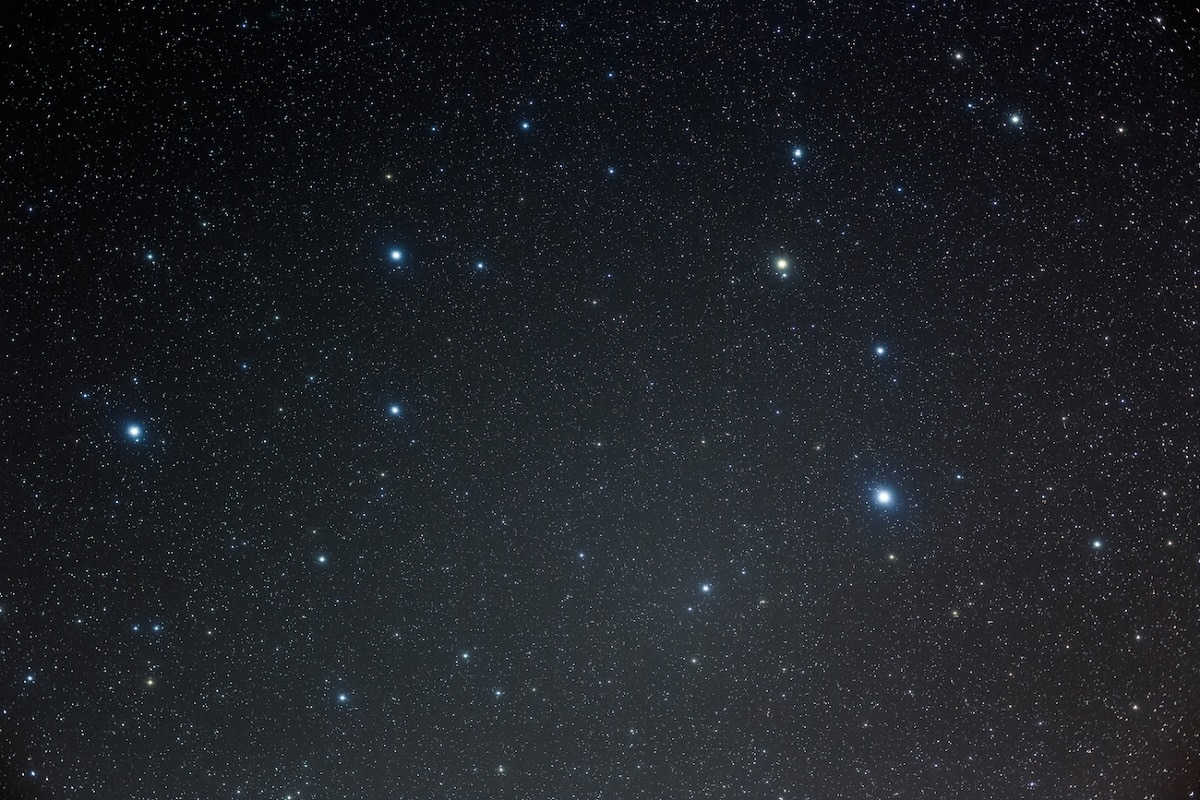
Amongst the myriad of constellations that grace the night sky, one of the most prominent is Leo, the Lion. Positioned between the constellations of Virgo and Cancer, Leo boasts several prominent stars and is also associated with several meteor showers that are typically observed during the winter months.
This article aims to provide a comprehensive overview of the Leo constellation, including its defining characteristics and notable features.
Main features
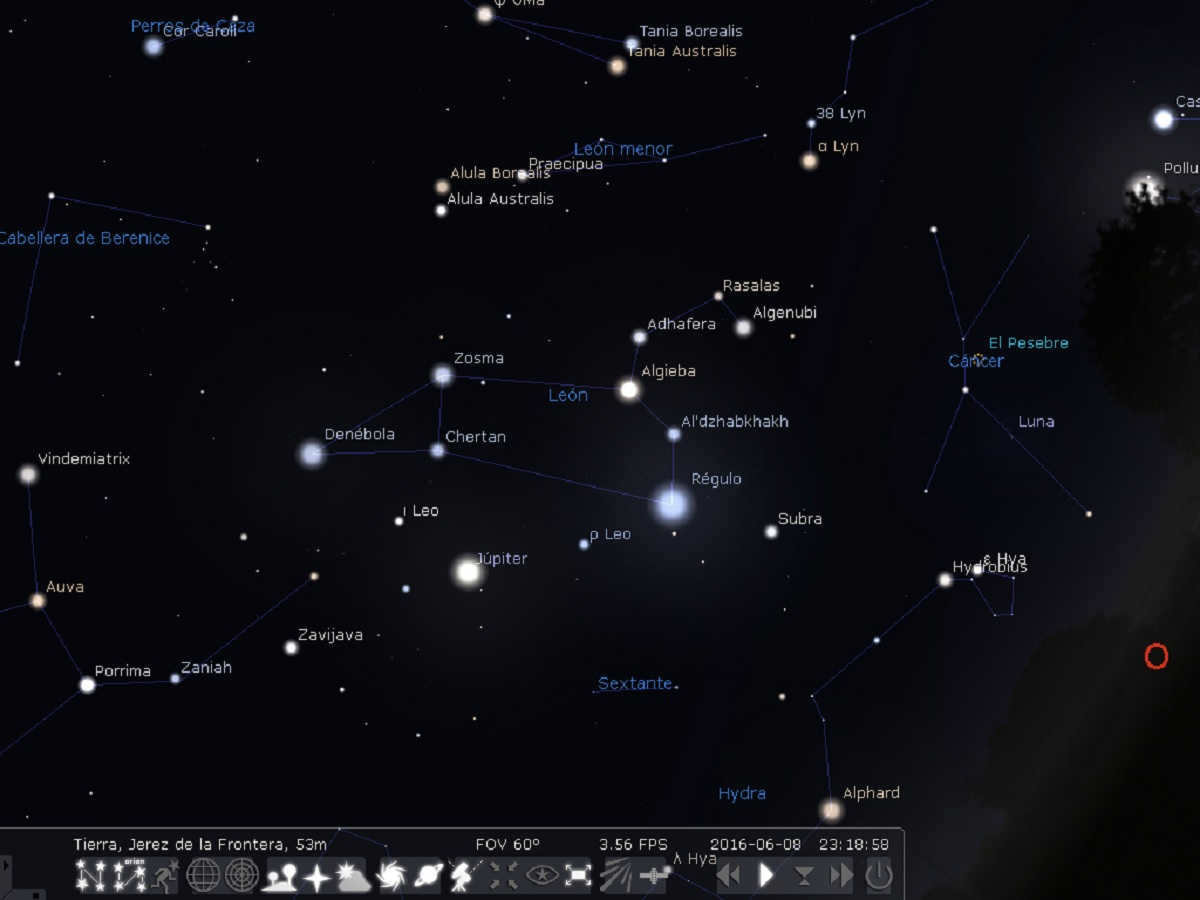
There are two meteor streams that are connected with this constellation: the Delta Leonid, which is active from February 15 to March 10, and the Leonid, which is active from November 10 to 23. Leo is a large equatorial constellation that represents the lion. During the months surrounding February, it can be seen higher in the midnight sky. The brightest star in Leo, Regulus, is located very close to the ecliptic, which is the path that the sun follows in the sky each year. Every year, from mid-August to mid-September, the sun passes through Leo.
Located to the north of Regulus, the lion’s mane is depicted by the curvature of the second and third stars. Positioned away from the plane of the Milky Way, the most prominent celestial object in this region is the Ninth Star or Faint Galaxy. The Leo Triplet, comprised of the gravitationally bound galaxies M65, M66, and NGC 3628, shines as the brightest among them.
In Greek mythology, Leo is famously known as the Nemean lion that was slain by Hercules. The lion possessed invincible skin, rendering it impervious to all weapons, with even Heracles’ arrows bouncing off its surface. Upon strangling the beast, Heracles utilized its skin as a protective cloak.
Tips on locating the Leo constellation

Out of the 13 constellations that make up the zodiac, the lion constellation is easily one of the most recognizable in the night sky. When people first search for Leo, they often look for its distinctive pattern: an upside-down question mark shape. This particular star formation, also known as the sickle of Leo, stands out prominently. At the bottom of the inverted question mark, you’ll find Regulus, which happens to be the brightest star in the entire Leo constellation.
Looking at it from the perspective of the northern hemisphere, the lion is associated with pleasant weather, as it jumps into the sky during the afternoon of the vernal equinox in March. March, April, and May are the months when you can easily spot the Lion constellation. Once the night falls, this constellation becomes visible and remains in the sky until early morning. Make sure to look for the reversed question mark shape.
The triangular formation of stars in the eastern part of Leo represents the lion’s back and tail. The brightest star in this triangle is known as Denebola, which translates to “lion’s tail” in Arabic. Just like other stars, Leo stars shift their position in the sky by four minutes every day or two hours every month.
In the beginning of April, the Leo constellation reaches its highest point in the sky at around 10:11 (4:5 local daylight time) and starts to lower below the western horizon at approximately 1:8 (9:00 local time). On May 2nd, Leo reaches its peak visibility during the night at around 3:XNUMX. Local time (XNUMX:XNUMX, local daylight saving time). Similarly, in early May, the majestic Lions begin to set in the west around XNUMX o’clock in the evening. Local time (XNUMX o’clock in the morning, local daylight saving time). In June, the Leo constellation can be observed descending from the western sky in the afternoon.
The primary stars in the constellation of Leo
Let’s take a look at the major stars in the Leo constellation:
- Denebola: Denebola, also known as Beta Leonis, is a bright white main-sequence star located approximately 36 light-years away from Earth. It has a mass and radius that are only 75% larger than our Sun.
- Zosma: Zosma, also known as Delta Leonis, is another white main sequence star situated about 58 light years away from Earth. It has a mass and radius approximately twice that of our Sun.
- Chort: Chort, also called Theta Leonis, along with Denebola and Zosma, forms the hip of Leo in the shape of a luminous triangle. Like the other two stars, Chort is a white main-sequence star. It is located 165 light-years away from the pair, which creates an incorrect visual effect.
- Regulus: Regulus, also called Alpha Leonida, stands out as the most brilliant star in the constellation and one of the brightest stars in the entire night sky. Situated approximately 80 light-years away from our planet, this four-star system includes the luminous Regulus A and three dimmer stars. Regulus A, a massive blue main-sequence star, boasts a mass and radius roughly four times that of the Sun.
- Algieba: Gamma Leonis, commonly referred to as Algieba, comprises a binary star system located around 130 light-years from Earth. This system consists of two massive double stars that orbit each other at a distance of about 16 billion miles (26 billion kilometers).
- Adafera: Also known as Zeta Leonis, Adafera represents a colossal white-yellow star positioned approximately 270 light-years away from Earth. With a diameter approximately six times larger than that of the Sun and a mass about three times greater, Adafera truly commands attention.
Legend and Folklore

Similar to the various constellations, Leo also derives from the exploits of the heroes from Greek mythology, particularly Hercules, the son of Zeus. Driven to madness by his stepmother, the noble warrior tragically took the lives of his six children in a fit of blind rage. Upon recovering from his temporary insanity, Hercules made a valiant effort to make amends for his heinous actions. Eventually, he was placed under the authority of King Eurystheus, who assigned him a series of challenging tasks to fulfill.
The initial step in accomplishing these tasks involves eliminating the lion that has been causing terror in the city of Nemea. This particular lion, which is unfamiliar to Hercules, is distinguished by its golden fur coat and imperviousness to arrows and swords. During his first encounter with the lion in its den, Hercules discovered that his arrow simply bounced off the creature. During his second visit, the hero blocked one of the two entrances to the den, armed himself with a large club, and proceeded to strike and strangle the lion.
By learning about the constellation Leo and its characteristics, you can gain further insight into this topic.
The content of this article adheres to our principles of editorial ethics. To report any errors, please click here.
Read the complete article: Network Meteorology " astronomy " The Leo constellation
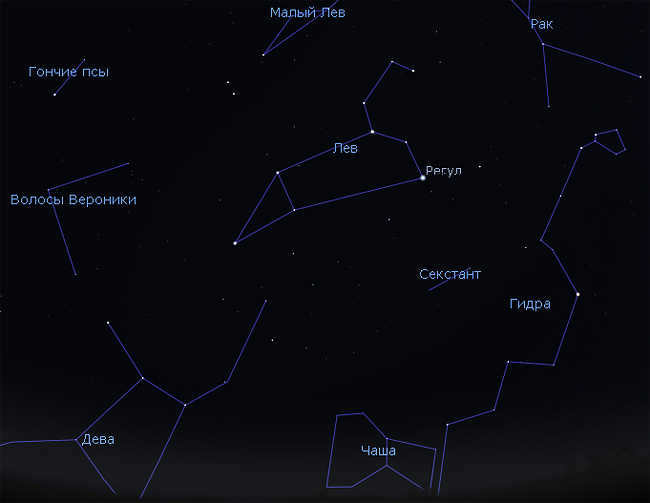
Most constellations have little resemblance to their namesake. For instance, the constellation Pegasus does not strongly resemble the legendary winged horse, and the constellation Lynx does not bear much resemblance to the forest predator.
However, the constellation Leo is an exception to this. With just a bit of imagination, one can easily identify and recognize the king of beasts in the pattern formed by its brightest stars. The shape of this constellation is simple yet striking, making it easy to remember. As a result, Leo is often used as a guide to locate nearby constellations that are not as distinct.
So, the question is: how can one locate the constellation Leo in the night sky?
First of all, let’s establish a specific time for our search. We should consider looking for it in the evening as it is more convenient compared to the night or early morning. During the night, we are usually asleep, and in the morning, we are rushing to go to school or work.
During the evening hours, we can observe the Leo constellation starting from February. During this time, Leo can be seen rising in the eastern sky shortly after dusk and can be observed in the southeast later in the evening.
In February evenings, the Leo constellation rises in the eastern sky during the late evening. Image: Stellarium
Leo can be easily distinguished from other constellations by the presence of a unique feature – a large trapezoid formed by four stars.
This trapezoid is almost the same size as the dipper of the Big Dipper and the brightness of its stars is comparable to those of the famous constellation. The brightest star in the Lion Trapezium is located in the lower right corner and is called Regulus. It is not only the main star of Leo, but also the 20th brightest star in the night sky.
Finding the trapezoid is not difficult at all – it will immediately catch your attention if you look in the right direction! In February, the trapezoid can be seen in the evenings in the east and southeast, but it is important to note that it appears tilted.

The constellation Leo can be seen in the evening sky during the month of March, specifically in the southeast direction. This is the best time to observe Leo, especially during the spring season. In March, as the sun sets, Leo will appear in the southeast and will be positioned at a moderate height in the sky, approximately halfway between the horizon and the zenith.
The Leo constellation is at its highest point in the sky during the evenings of April. It can be seen in the southern part of the sky and dominates the spring sky, as the other constellations in the vicinity are quite faint. In fact, only two stars, Arcturus and Spica, shine brighter than Regulus in the spring sky. However, the constellations they belong to, Capricorn and Virgo respectively, are also relatively dim. In April, the Leo constellation appears in a horizontal position resembling a trapezoid, making it fairly easy to locate in the sky.
By the way, if you still have doubts about spotting the Leo constellation on your own, remember that it is located below the handle of the Big Dipper! Armed with this knowledge, you can quickly find the Leo constellation at any time of the day or year, as long as it is above the horizon at that particular moment.
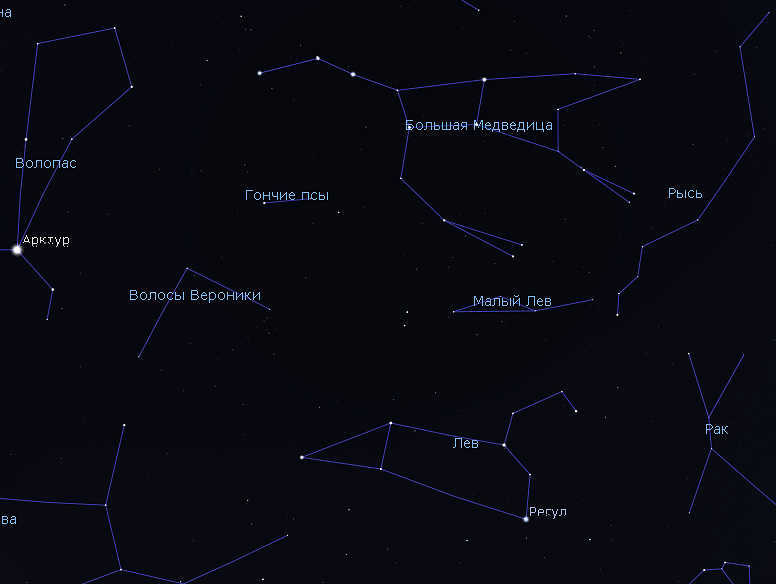
During the spring months, the Big Dipper reaches its highest point in the sky, while the Leo constellation can be observed below it in the southern part of the night sky. This positioning can be seen in the image provided by Stellarium.
As the month of May progresses, the nights grow darker, allowing for better visibility of the Leo constellation. It can be seen in the southwest during the evenings and remains in the sky for only a short period before disappearing below the horizon.
Now, you may wonder why this particular constellation was named Leo, which means lion, instead of a name like Trapezium.
If you happen to spot the constellation Leo in the night sky, make sure to pay special attention. Just above the right side of the trapezoid shape, there are three additional stars that, when combined with Regulus and the star Algieb (located at the upper right corner of the trapezoid), create a formation that resembles a question mark facing in the opposite direction. This particular formation has been given the name Sickle by the ancient people due to its striking similarity to an old agricultural tool.
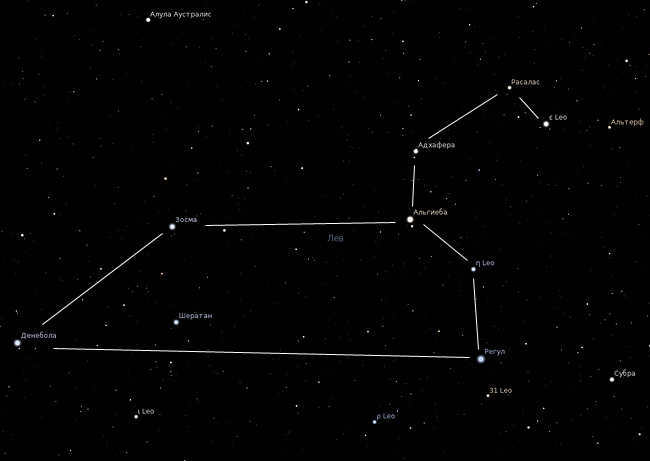
The constellation known as the Sickle of the Lion is represented by the handle of a sickle, which is indicated by the star Regulus. The sickle itself is marked by the stars Algieb, Adhafera, Rasalas, and Leo epsilon. In ancient maps, this area was depicted as the forelegs, chest, and head of a reclining predator. This image can also be interpreted as the predator lying with its head up, gazing towards the west.
Furthermore, if you look up at the night sky on a dark and clear night, you can also spot the Lion’s tail. But we will discuss this particular star pattern later on.
Even without any optical aids, one can observe the celestial formation known as the Lions constellation in the nocturnal expanse. Astronomers have dedicated considerable attention to studying the neighboring constellations of Big and Little Leo. So, when and where can one catch a glimpse of these constellations? And which celestial entities comprise these formations? These are the questions we shall explore further.
Both of these constellations are positioned in the Northern Hemisphere. Undoubtedly, the Big Leo is the more renowned of the two. It takes its inspiration from the very creature that the hero of Greek mythology, Heracles, valiantly battled. On the other hand, the Lesser Lion resides amidst the Big Dipper and the Lion. The close proximity of these constellations in the night sky does not warrant amalgamating them under the collective moniker of “Constellation of Lions”. They are more commonly referenced individually.
And for a good reason. After all, the Great Lion has much to be proud of. Its Regulus (which means “king” in Latin) shines 160 times brighter than our Sun and is about 3 times larger. Other bright stars in the Leo constellation include Denebola, Algieba, Zosma, and Algenubi.
Located next to constellations such as Virgo, Cancer, Sextant, and Chalice, Leo boasts a total of about 70 stars, although most of them are faintly visible.
In terms of shape, the constellation resembles an irregular hexagon, with a curl on one side that resembles an inverted question mark. This curl represents the lion’s mane, with its six stars forming the famous Sickle asterism.
The Leo constellation also features several interesting objects, including galaxies, double stars, and variable stars, which can only be observed with a powerful telescope.
The best time to observe the constellation is during the months of February and March, and in the middle of November, you can witness the impressive Leonids meteor shower, which reaches its peak on November 17.
Exploring the Leo Minor Constellation
Leo Minor is a small constellation that consists of 34 stars. It is most visible during the spring and summer seasons. However, unlike its larger counterpart, it lacks any notable features and its brightest stars do not form a distinct shape.
Leo Minor was first discovered by Jan Hevelius in 1610 and included in his atlas “Uranographia”. Interestingly, astronomer Francis Bailey only acknowledged the second brightest stars in the Lesser Lion, completely overlooking the first.
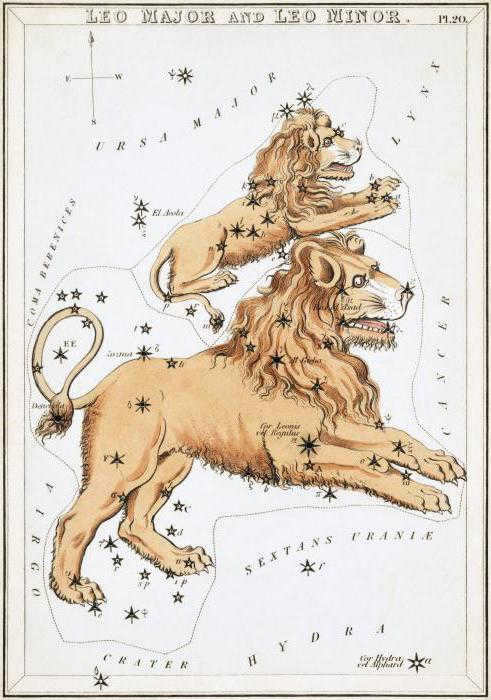
Summary
There are two adjacent constellations known as the Lions. They are commonly visible in the Northern Hemisphere, especially during the spring season. These constellations were placed side by side on celestial atlases because it was believed that the Lesser Lion should have a similar influence as the Greater Lion.
Quote The constellation of Leo in astronomy, astrology, and mythology
Leo dominates the zodiacal sky from July 23 to August 22. The Lion is a symbol of royalty, representing strength and power, and does not tolerate any form of competition.
Meanwhile, in the field of astronomy, there are two constellations of Leo that are situated side by side. Astronomers have positioned them adjacent to each other on celestial atlases due to the belief that the Lesser Leo should possess a similar influence to the Greater Leo. In the Northern Hemisphere, these constellations are visible almost always, with the best viewing opportunities occurring in the spring months of February and March.
The close proximity of these constellations in the night sky does not warrant them being collectively referred to as the “Constellation of Lions”. They are typically mentioned individually.
The Lesser Lion constellation is positioned between the Big Dipper and Leo. It is a rather small constellation, consisting of 34 stars. This constellation is not as remarkable as its larger counterpart.
The constellation Leo Minor was initially observed and recorded by Jan Hevelius in 1610, who included it in his atlas Uranographia.
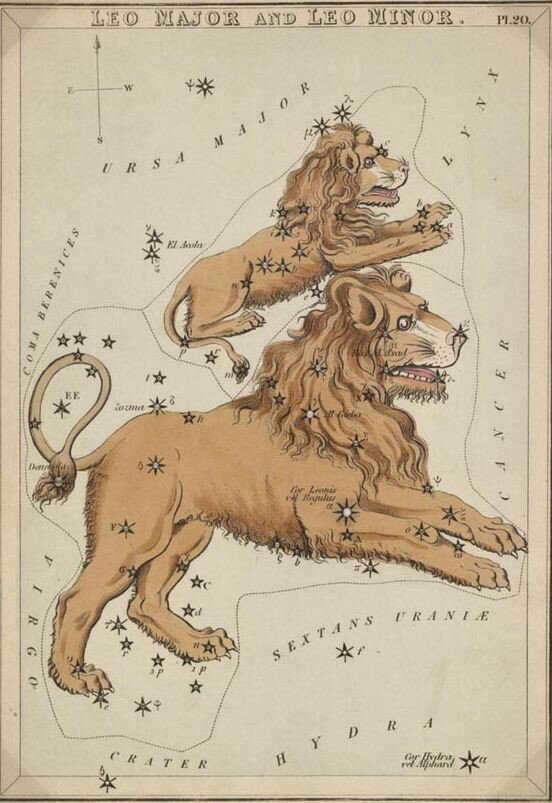
A depiction of the Leo constellation taken from the atlas of Jan Hevelius.
The constellation is commonly referred to as the Great Lion. And with good reason. The Great Lion has much to be proud of. Its most brilliant star, Regulus (derived from the Latin word for “king”), shines 160 times brighter than our Sun and is approximately three times larger. It is also sometimes known as the “Heart of the Lion” (Cor Leonis).
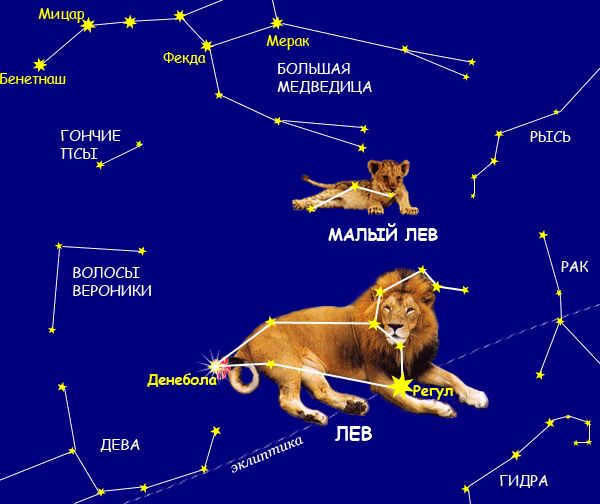
Located at the foundation of the Lion’s Head is the most luminous star, Algieb (γ Leo), known for its representation of the lion’s mane. In the month of January 2001, astronomers made a significant breakthrough by detecting a massive celestial body, eight times larger than Jupiter, in orbit around Algieba.

The configuration of brilliant stars does bear a resemblance to a lion lying down, with its head and chest forming the well-known Sickle asterism, which takes on the appearance of an inverted question mark.
The trio of stars at the rear of the Lion figure commences with the star Denebola (β Lion), which translates to “lion’s tail”. In total, there are approximately 70 stars, although the majority of them can only be faintly perceived.
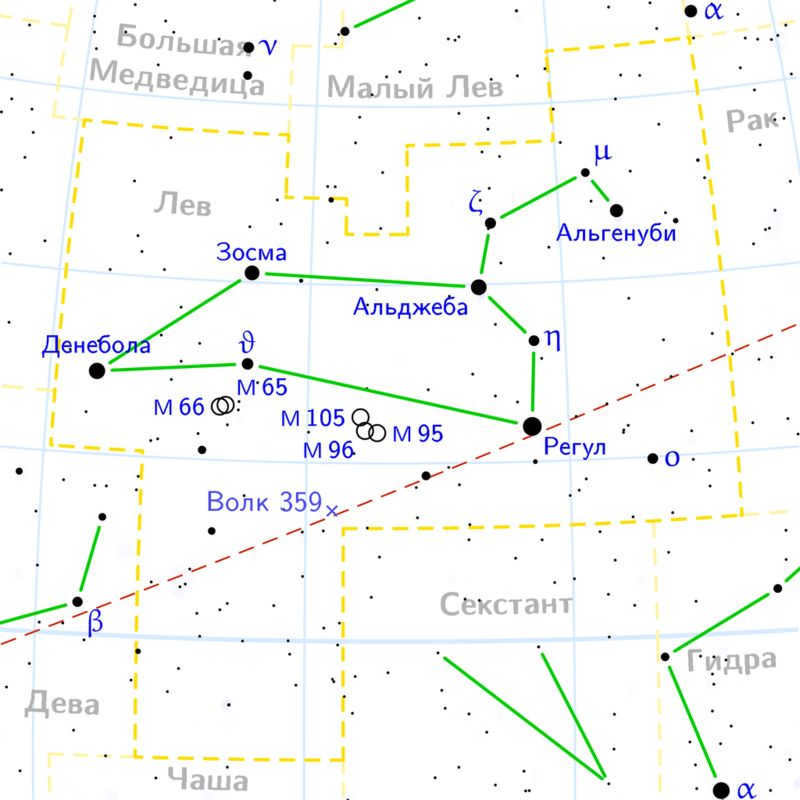
Leo contains several bright galaxies, such as the Lion Triplets M66, M65, and NGC 3628. The Lion Ring consists of a collection of hydrogen and helium, which is in orbit around two dwarf galaxies. Additionally, the Leonids meteor shower is visible in mid-November, with its peak occurring on November 17.
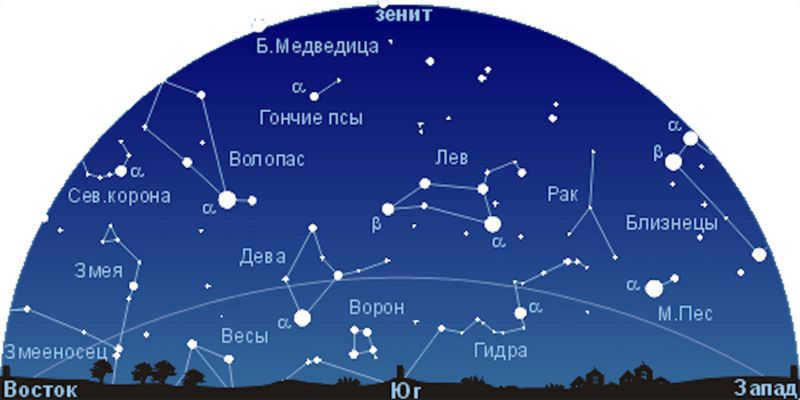
Leo is one of the oldest constellations that have been identified. The people of Mesopotamia were the first to record this constellation and they named it “Lion”. Other cultures also have different names for this constellation such as the Persians who called it “Ser” or “Shir”, the Turks who called it “Artan”, the Syrians who called it “Aguo”, the Jewish nation who called it “Ague”, and the Indians who called it “Simha”. However, all these names have the same meaning, which is “Lion”.

Lysippus, a renowned sculptor from ancient Greece during the early Hellenistic period in the 4th century BC
The constellation Leo symbolizes the Nemean Lion, which was famously slain by Hercules as part of his first of twelve labors, seeking vengeance for the murder of his family. In accordance with Greek mythology, the Lion resided in a mountain valley near the city of Nemea in the region of Argolis, causing havoc and taking the lives of its inhabitants. The lion possessed extraordinary size and strength, and its skin was so impenetrable that neither iron, bronze, nor stone could pierce it.
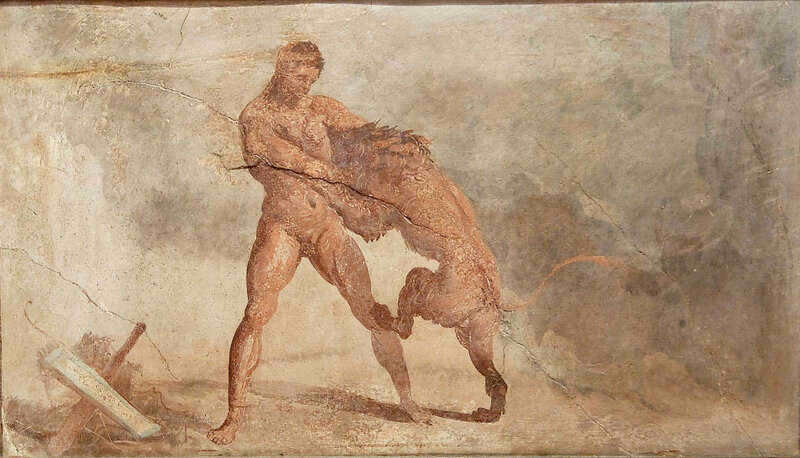
A painting found in Pompeii shows the epic battle between Heracles and the Nemean lion
During his journey to Nemea, Heracles made a stop at the farm of Molorchus. They made a pact that if Heracles did not return within 30 days, Molorchus would offer his last ram as a sacrifice to the rulers of the underworld. However, if Heracles returned in time, the ram would be dedicated to Zeus. It only took Heracles 30 days to locate the cave where the Nemean lion resided. He strategically blocked one entrance with stones and concealed himself near another, patiently waiting for the lion to appear. At sunset, the lion finally emerged, and Heracles fired three consecutive arrows at it, but unfortunately, none of them pierced the lion’s tough hide. The lion charged at Heracles, but he swiftly struck it with a sturdy stick carved from ash wood obtained from the Nemean grove. The blow stunned the beast, allowing Heracles to overpower and strangle it. As a testament to his victory, he brought the slain lion to the heavens.
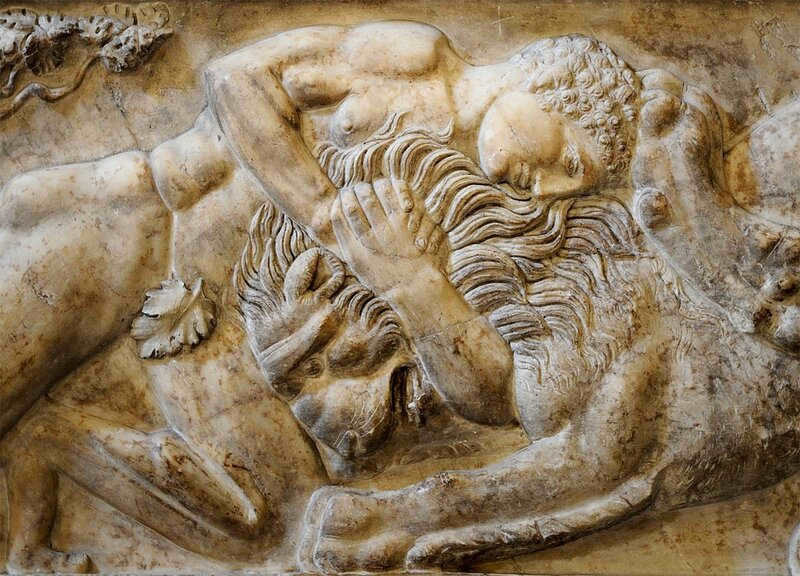
Frontal wall of the marble sarcophagus relief
Anciently, approximately 4,500 years ago, the Lion constellation marked the summer solstice point. In hot southern regions, this time was characterized by intense heat, leading many cultures to associate the Lion with fire. The Assyrians referred to it as the “Great Fire”.
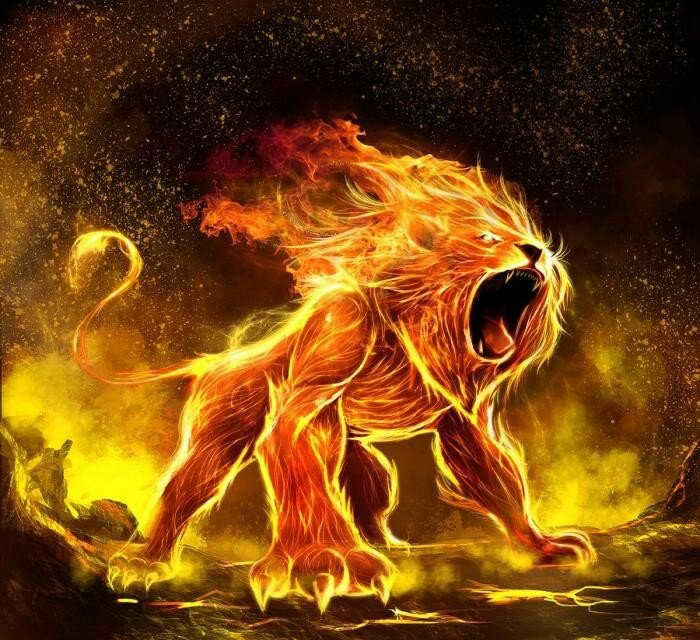
During this period in Egypt, the flooding of the Nile would begin, coinciding with the summer solstice. As a result, the gates of the sluices, which directed the waters of the river through canals to the fields, were designed in the shape of a lion’s head. This is why, even today, water flows out of the lion’s mouth in fountains. However, the origin of this tradition is often overlooked and not much thought is given to it. 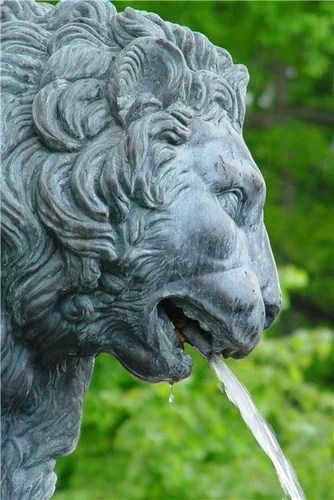

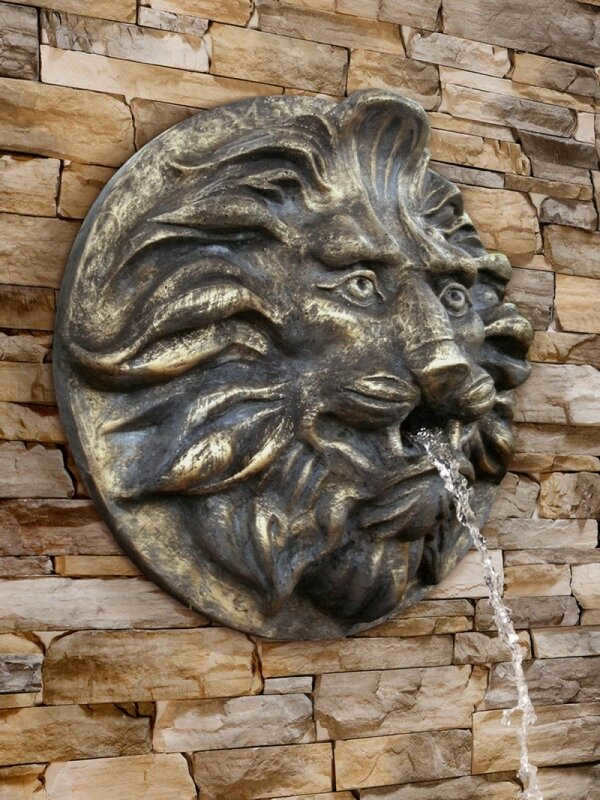
Astrology is not a scientific discipline, but it follows its own set of principles. Leo is the fifth zodiac constellation, which occupies the sector of the ecliptic ranging from 120° to 150° starting from the vernal equinox.
According to Western astrology, the Sun is said to be in the sign of Leo from around July 23 to August 21. It’s important to note that the sign of Leo should not be mistaken for the constellation Leo, which the Sun is in from August 10 to September 15.
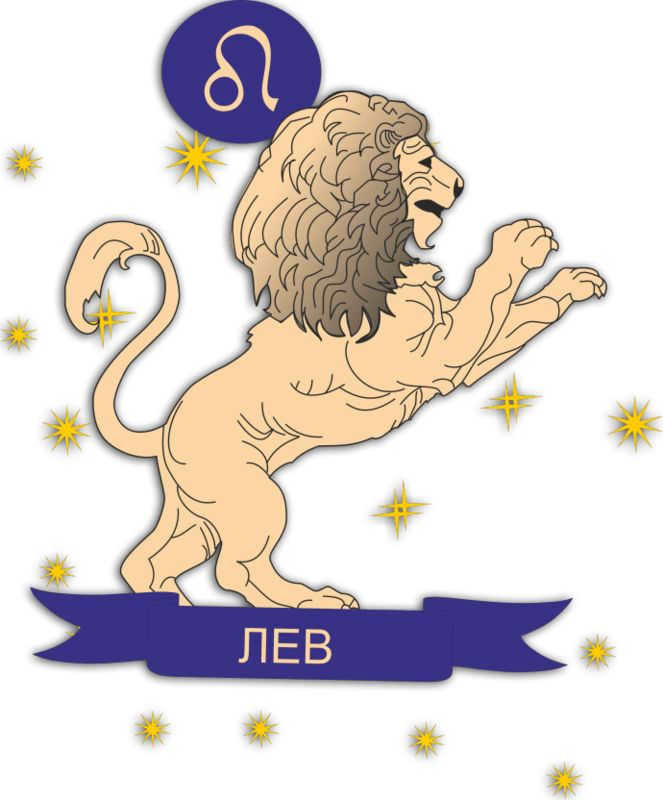
The fortunate color for Leo is gold, orange, white, and red.
Sunflower is the preferred flower for Leo sign.
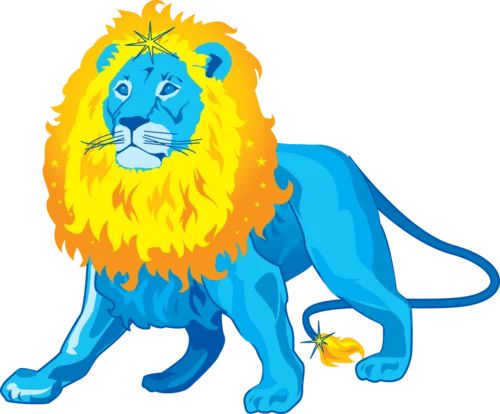
The zodiac sign Leo is often associated with masculine energy and extroversion. Each Leo is believed to possess a natural luck that helps them overcome any challenges they may face.
Leos can be divided into two groups – those who value status more than money, and those who prioritize financial success. However, when a Leo leads with their heart, they have the ability to overcome any obstacles that come their way.
Like all natural leaders, Lions are constantly driven to create and innovate, both in the spiritual and material realms. They are willing to invest significant resources – money, time, and knowledge – to achieve their goals, often putting their own needs aside in the process.
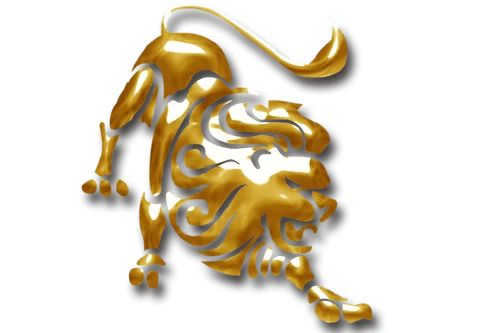
The constellation of Leo is known for its strong attraction to the opposite sex, but they are often taken advantage of due to their trusting nature. Leos are prone to being deceived by those they trust, as they trust others as much as they trust themselves.
Leos are honest individuals and do not engage in cheating. If they discover that their partner has committed this sin, a disappointed Leo may give up on love altogether. Lions despise being blatantly lied to, and if they learn that someone has lied to them, they will cut that person out of their life forever. In such a case, the Lion’s respect can never be regained.
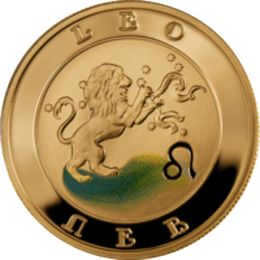
Lions possess a remarkable sense of loyalty and will readily defend their companions and loved ones. They harbor no fear and are unhesitant in confronting any perceived threat, fearlessly tearing their adversaries apart. This behavior can be attributed, in part, to their possessive nature, but the underlying reasons for such ferocity remain a mystery even to the Lions themselves. It’s as if there is an internal transformation taking place during these moments, fueling their strength and courage.
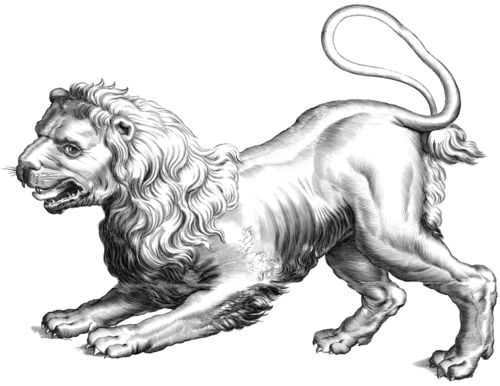
Lions are known for their daring and dynamic nature, yet surprisingly, they are the least prone to injuries and accidents. This characteristic extends to their driving skills as well, as statistics show that Lions are the least likely to be involved in car accidents. Experts attribute this to their confidence and cool-headedness.
Lions remain calm even in the most extraordinary circumstances. While others may panic and lose control, Lions remain composed and focused on finding a solution. However, they can be thrown off balance by human stupidity or having to endure long waits.
Waiting is something that Lions despise. Compared to other Zodiac signs, Leos are less inclined to wait in line. If you find yourself waiting alongside a Leo, it can be an incredibly challenging experience. Therefore, it’s best to avoid such situations when in the company of a Leo.
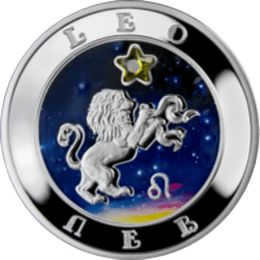
Lions have a strong affinity for luxurious items that showcase their elevated status, although this preference does not extend to all aspects of their lives. There are certain things that hold immense importance to them, and they would never willingly part with them. While some Lions enjoy dining at upscale restaurants, others prefer driving expensive cars, and some have a penchant for fashionable clothing. They are willing to make sacrifices in order to indulge in these pleasures.
When it comes to their self-perception, Lions always maintain a rather high opinion of themselves. However, their pride is their Achilles’ heel, as they are highly susceptible to flattery and it is perhaps the easiest way to win them over. On the other hand, even the slightest criticism can lead to a breakdown in peaceful coexistence.
That’s just the way Lions are.
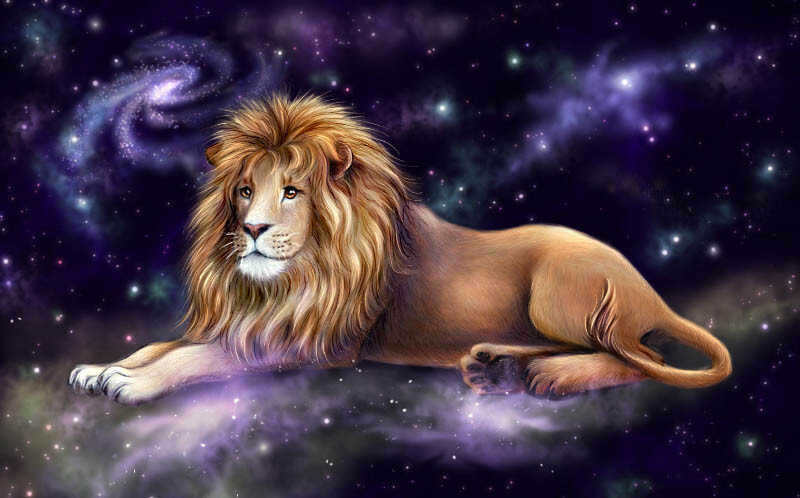
Individuals born under the sign of Leo go through three stages of soul development. The highest stage is symbolized by the Sphinx, a mythical creature known for its wisdom and guidance. The second stage is represented by the Lion, the king of the jungle, who balances the Leo’s ego and always supports and defends their loved ones. The final stage is the Lion cub, representing immaturity, fear of the unknown, and a lack of fully formed identity.
The arrangement of the bright stars in the Leo constellation closely resembles a reclining lion. The head and chest of the lion form the distinct Sickle asterism, which resembles a mirrored question mark.
The bright blue-white star Regulus (α Leo), which means “king” in Latin, is represented by the “point” at the bottom of this sign. It is sometimes referred to as the “Heart of the Lion” (Cor Leonis). Regulus is 160 times more luminous than the Sun and appears very bright (1.36 magnitude) due to its close proximity to us (85 sidereal years). Among the stars with a magnitude of 1, Regulus is the closest to the ecliptic, making it frequently covered by the Moon.
Denebola (β Leo), which translates from Arabic as the “tail of the lion,” is located in the rear part of the figure of the beast. It has a sidereal magnitude of 2.14 and is situated 43 sv. years away.
At the base of the “lion’s head” is the golden-yellow star Algieba (γ Leo), which means “lion’s mane.” It is a visually close double star with a magnitude of 2.0.
R of Leo is a highly luminous long-period variable star. It has a brightness that varies from 5th to 10th magnitude. Wolf 359, a red dwarf star, is located relatively close to us, with a distance of 7.80 light-years. However, its luminosity is 100,000 times less than that of the Sun. If Wolf 359 were to replace our Sun, it would appear slightly brighter on Earth at noon than the full moon.
Within the Leo constellation, there are several interesting spiral and elliptical galaxies. These include M 65, M 66, M 95, M 96, and M 105. These galaxies have an apparent luminosity ranging from 8.4 to 10.4 star magnitudes.
Sickle Asterism
The Sickle asterism is made up of six stars in the constellation – α (Regulus), η, γ (Algieba), ζ, μ, and ε (Algenubi). Its shape resembles that of a sickle or a mirrored question mark.
Observation
Typically, the Sun is in the constellation from August 10 to September 15. The best conditions for observing are in February and March.
Within the constellation Leo, the radiant of the Leonids meteor shower can be found. This meteor shower is formed from the debris of the comet Tempel-Tuttle and is observed in mid-November.
Background
The history of this constellation dates back to 5000 years ago when the Sumerians first identified it. It was later included in the Almagest catalog of the night sky. In classical mythology, Leo is linked to the legendary defeat of the Nemean monster. One of the earliest references to this constellation in Russian can be found in an 11th-century manuscript published by A. Budilovich, titled “XIII words of Gregory the Theologian in Old Slavonic translation…”.
Leo (astrological sign)
Leo is the fifth astrological sign in the zodiac, representing the section of the celestial sphere from 120 degrees to 150 degrees, starting from the vernal equinox point. It is classified as a fixed fire sign.
In Western astrology, the Sun is believed to be in the sign of Leo from around July 23 to August 22, while in Vedic astrology it is from August 15 to September 15. It is important to note that the sign of Leo should not be confused with the constellation of Leo, where the Sun is present from August 10 to September 15.
The Unicode character for Leo ♌ (may not be visible in certain browsers) has a decimal representation of 9804 or a hexadecimal representation of 264C. It can be displayed in HTML as ♌ or ♌.
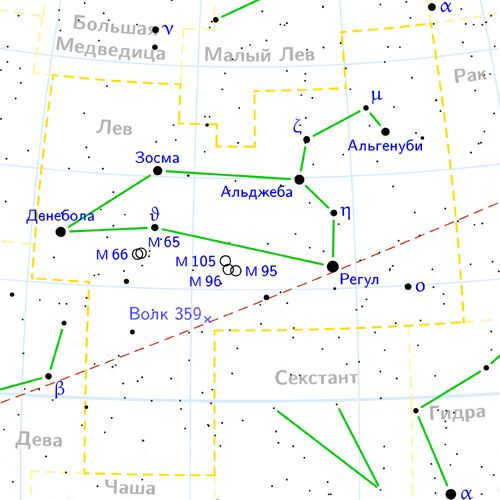
Tap the picture to enlarge it
Estimated reading time: 8 minutes
Share
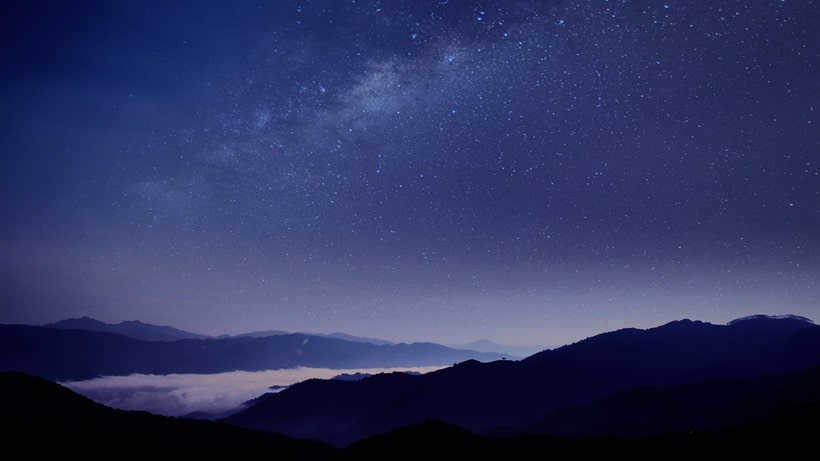
- Natal Astrology
- Relationship Astrology
- Self Development and Psychology
- Predictive Astrology
- Horoscopes and Predictions
- Talismans
- Soul Formula
- Numerology
- Astrological Tarot
- World Astrology
- For beginners
- For professionals
- Development of an Astrologer
Read 8 min
What is the constellation of Leo? The constellation of Leo has been known to astronomers since ancient times and is considered to be one of the most stunning constellations. It was admired in ancient Mesopotamia and referred to as the “Big Dog”. It was also recognized in medieval Europe. The distinctive pattern of this constellation was observed in ancient Russia.
Where can you see it? It is now visible almost all the time, particularly in the Northern Hemisphere, although the best time to observe it is during spring. To find it in the sky, orient yourself towards the handle of the Big Dipper.
General information about the Leo constellation
The Leo constellation is the twelfth largest constellation out of all the constellations.
The Leo constellation ranks twelfth in terms of magnitude among all the constellations and fifth in terms of visibility in the Northern Hemisphere. It is intersected by the celestial equator and the ecliptic lines. In 1603, Johann Bayer proposed a naming system in which the Leo constellation was designated by the Latin word Leo, and the stars in this constellation were referred to in the genitive case – Leonis.
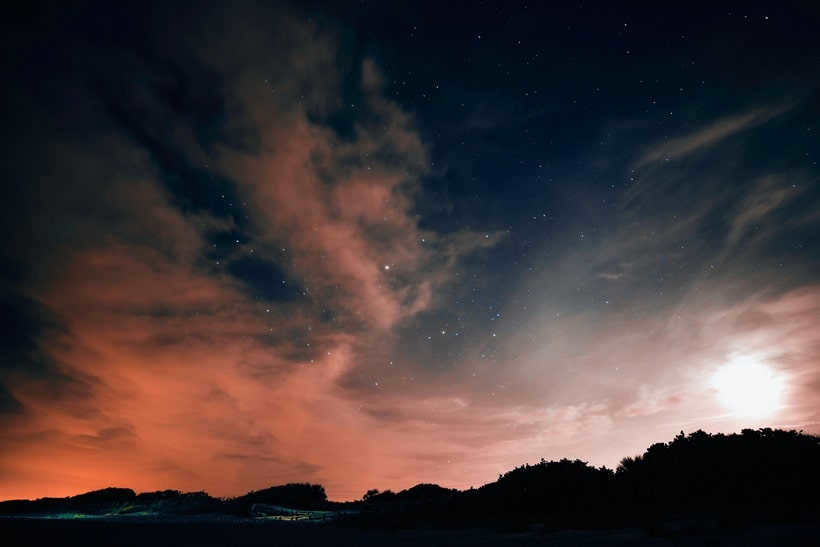
The constellation of Leo is an important celestial feature and serves as a useful guide for locating other star clusters due to its abundance of bright stars. It is considered a spring constellation by astronomers as it reaches its highest point above the horizon during this season. However, it can be observed throughout the year in the Northern Hemisphere.
An interesting observation has been made regarding the main stars of Leo, as they form a geometric shape that resembles the ancient Egyptian sphinxes. The main outline of this shape is a trapezoid, with stars of comparable size and brightness to those found in the Big Dipper.

What is the appearance of the Leo constellation? To observe it, direct your gaze towards the southeastern region of the sky during a period of clear weather and darkness. This assemblage of stars is particularly popular among novice astronomers due to its abundance of captivating celestial objects.
Etymology of the name
Thanks to its brilliance, mankind has been observing the constellation for over a thousand years. The Sumerians were the first to take notice of it, and they even named it “Great Canine”. Additionally, many cultures perceived this group of stars as a representation of the king of the animal kingdom.
Various names meaning “lion” were ascribed to it:
- In Persia – Shir or Ser.
- In Mesopotamia – Lion.
- In Syria – Aryo.
- In Turkey – Artan.
- Ancient Hebrew people – Arye.
- Indian tribes – Simba.
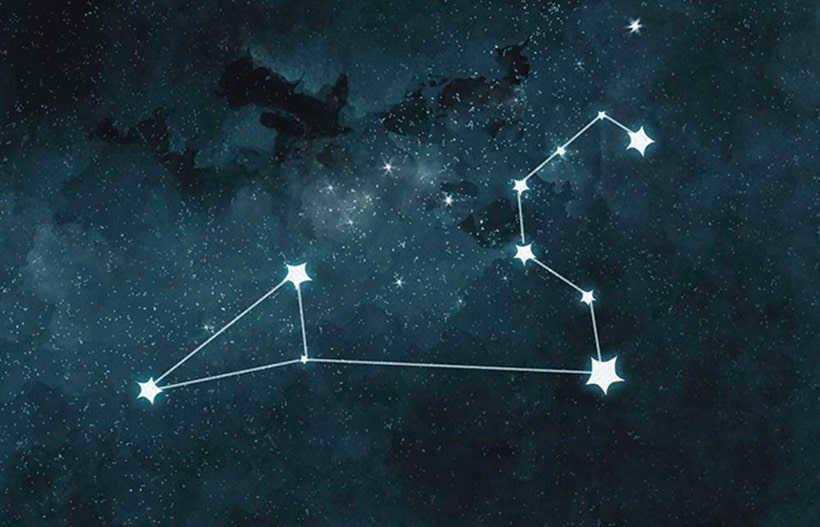
Claudius Ptolemy, the ancient Greek mathematician and astronomer, followed the customs of his time and assigned all the stars that formed the shape of a lion to the constellation in a typical representation for his contemporaries. During the Middle Ages, scholars adhered to the principles of the “divine view” and portrayed such star clusters in an external projection, as if observing them from outside rather than from Earth.
In the 1610 atlas “Uranographia” by astronomer Jan Hevelius, Leo appears as depicted. Additionally, the scientist identified the nearby constellation of the Lesser Lion, which consists of only 34 stars.
The people of Babylon, along with the Persians, Assyrians, and Egyptians, had their own unique stories and folklore surrounding the Leo constellation. Around four and a half thousand years ago, this constellation marked the point of the summer solstice. It was commonly associated with scorching heat, the start of dry spells, and wildfires. This is why Leo has come to symbolize fire. Nowadays, the Sun travels through the Leo constellation from the second third of August to September 17.
During ancient times in Egypt, the constellation was easily seen above the horizon during the flooding of the Nile. It is possible that this is when the tradition of constructing sluice gates for canals in the shape of a lion’s head originated. The period when the Sun was in Leo was regarded as the most auspicious and important for the birth of pharaohs and influential leaders.
According to an ancient Greek legend, there was a Nemean lion that resided in the heavens.
An ancient Greek legend recounts the tale of the Nemean lion residing in the heavens. This colossal creature, impervious to spears, dwelled near the city of Nemea in the Peloponnese region. It instilled fear in the local populace, consuming all living beings in its wake. Hercules triumphed over it, initiating a sequence of events known as the “12 labors of Hercules”. And in commemoration of his triumph over the lion, Zeus placed the creature among the stars.
Where can Leo constellation be found and how to locate it?
How can one locate the Leo constellation? It is situated in the Northern Hemisphere, nestled between the constellations of Virgo and Cancer. Being a zodiacal entity, this group of stars resides along the ecliptic, which is the annual path of the Sun as observed from our vantage point on Earth.


In addition, Leo is situated adjacent to several well-known star clusters, including the Great Bear, Hydra, Lynx, Veronica, and the aforementioned Virgo and Cancer.
When the Moon approaches the constellation of Leo, it can act as a guide for finding it. Another method is to locate this cluster of stars using the bright, non-setting Big Dipper. By observing the Big Dipper, one can visualize water pouring out of its far edge, which aligns perfectly with the Lion’s withers. It is important to note that the constellation of Leo is distinct from the zodiac sign Leo. The zodiac sign Leo is considered when constructing a birth chart or individual development plan, while the constellation of Leo holds more astronomical significance rather than astrological.
The primary celestial bodies of the Leo constellation
The Leo constellation is characterized by six prominent stars that are arranged in the form of a curved blade, creating the head of the lion.
Among these, the most brilliant star is Regulus (Alpha Leo), which symbolizes the lion’s courageous heart. Denebola (Beta of Leo) resembles a decorative fringe on the lion’s tail. Algieba (Gamma of Leo) is positioned near the cheek area, despite its name meaning “forehead”. Lastly, Zosma (Delta of the Lion) can be found directly on the lion’s hip.
In total, there are approximately 120 stars within the Leo constellation. These stars are not as luminous as the primary ones and can typically only be observed using a high-powered telescope.
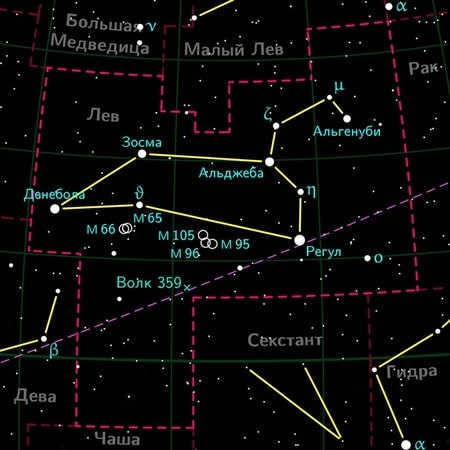
Which stars are the most important in this constellation?
Regulus, also known as α Leo (Alpha of Leo)
Regulus (Alpha Leo) is the brightest star in the Leo constellation and is the 22nd brightest among all the stars. It has an apparent magnitude of 1.35 and is located about 77 light-years away from Earth.
Regulus is part of a star system consisting of four objects and two pairs. It is a double spectroscopic main-sequence star that is in conjunction with a companion star (white dwarf). The stars orbit their common center of mass every 40 days.
The term Regulus translates from English as “Prince” or “Little King”. The same name for the star, Basiliscos, can also be found in Greek. In ancient Arabic, the star was referred to as Kalb al-Asad – “the heart of the Lion”.
The star Denebola, or β of Leo (Beta of the constellation Leo).
Denebola is the second brightest star in the constellation Leo and ranks 61st in the sky. In the star sequence, it holds a prominent position and has a B classification of A3. It has an apparent magnitude of 2.113 and is located approximately 35.9 light-years away from Earth. It is easily visible even without the use of binoculars.
Denebola surpasses the Sun in both mass and radius, with a 75% increase in mass and a 73% increase in radius. It is also 12 times brighter than our Sun. The star is classified as variable, meaning its brightness does not vary significantly over a few hours.
Beta Leo is a star that is considered to be quite youthful, with an estimated age of less than 400 million years. This star has a rotation speed of 128 kilometers per second.
Denebola earned its name from its Arabic counterpart ðanab, which can be translated as “the tail of a lion”.

Algieba: The Forehead Star in the Leo Constellation
Algieba, also known as γ Leo (Gamma of the constellation Leo), is a binary star system located in the Leo constellation. The name “Algieba” was given to it by the Arabs, derived from the Arabic word “Al-Jeba” meaning “forehead”.
The primary star in this system is a spectral giant of type K1-IIIbCN0.05, while the companion star belongs to the spectral class G7IIICN. The primary star is incredibly bright, being 180 times brighter than our Sun, with an apparent stellar magnitude of 2.28. The companion star has an apparent magnitude of 3.51 and is both 50 times brighter and 10 times larger than our Sun. These two celestial objects orbit each other with a period of 500 years.
Algieba is located approximately 130 light-years away from our Solar System and can be observed using a small telescope. Under favorable weather conditions, it appears as a distinct double star, with one component having a greenish-yellow color and the other component appearing orange-red.
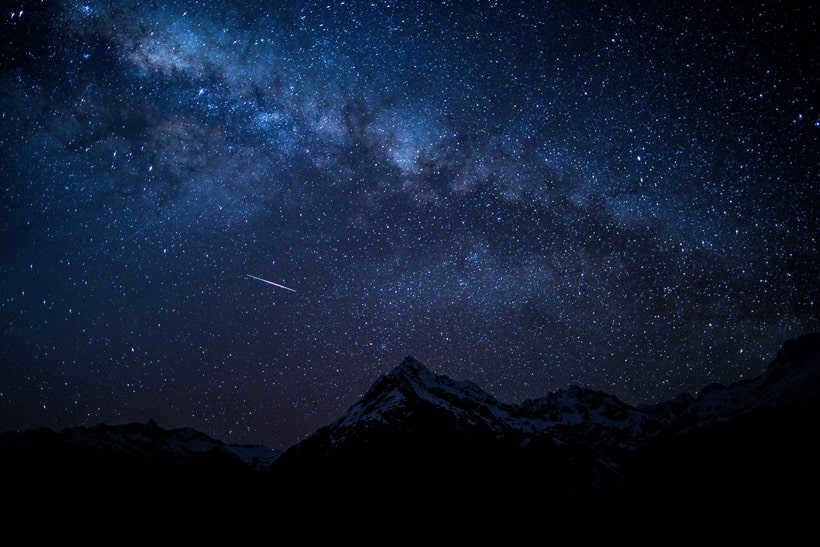

The star Zosma, also known as δ of Leo (Delta of Leo constellation)
The Zosma star (Delta of Leo) has an estimated rotational velocity of 180 km/sec. It shares similarities with Regulus and Denebola, including its equatorial bulge and elliptical shape.
Zosma is a white main sequence star belonging to spectral type A4 V, and it is located approximately 58.4 light-years away from Earth. Its apparent magnitude is 2.56.

The Delta Leonis star is larger and hotter compared to the Sun. Its radius is 2.14 times that of the Sun, and it is 15 times brighter. It is predicted that in approximately 600 million years, this star will evolve into a red giant.
This star’s name originates from ancient Greek and means “belt.” Zosma is positioned on the hip of the Leo constellation.
The celestial body known as Hort, or θ of Leo (Theta of the constellation Leo)
Hort, also referred to as Theta of Leo, is a shining white star that belongs to the main sequence of stars.
It falls under the stellar classification of A2 V. With a mass 2.5 times that of our Sun, Hort can be easily observed with the naked eye. Its apparent stellar magnitude is measured to be 3.324, and it is located at a distance of approximately 165 light-years from our solar system.
Hort is estimated to be around 550 million years old, making it significantly younger than our Sun. Scientists predict that this star rotates at a speed of approximately 23 km/sec.

The Theta Lion, also known as Hort, is given its name from the Latin word for “thigh” and the Arabic word kharātān meaning “two small ribs”.
Galaxies within the Leo Constellation
Messier 65 (M65, or NGC 3623)
Messier 65 is an intermediate spiral galaxy with a visible magnitude of 10.25. It is located approximately 35 million light years away from Earth.
This particular celestial object was discovered by the astronomer Charles Messier in 1780 and was named after him. Messier 65, Messier 66, and the galaxies NGC 3628 are collectively known as the “Lion Triplet” in the field of astronomy.
Due to the scarcity of gas and dust within Messier 65, the formation of stars is not as active. Consequently, the majority of celestial bodies within this galaxy are older in age.
The M65 galaxy has a disc shape. At some point, it was observed that it underwent a slight change in its inclination angle, indicating its interaction with another celestial object. Initially, it was hypothesized that this phenomenon could be attributed to recent star formation activity.

Messier 66 (M66 or NGC 3627)
Messier 66, which was also discovered by Charles Messier in 1780, has a spiral shape. It has a magnitude of 8.9 and is located 36 million light years away from Earth.
M66 spans about 95,000 light-years in length. This galaxy is notable for its clusters of exceptionally luminous stars. It is also part of the Leo Triplet star system.

It is a well-known fact that the galaxies M66 and NGC 3628 had a previous encounter, resulting in a significant concentration of mass in M66 due to their mutual gravitational interaction.
About Galaxy NGC 3628
NGC 3628 is another spiral galaxy located in the Leo constellation. It is located approximately 35 million light-years away from our solar system and was first discovered by William Herschel in 1784.
One of the notable features of this galaxy is its long tail, which extends for about 300 thousand light-years. Together with Messier 65 and Messier 66, NGC 3628 forms the famous “Lion Triplet”.
Galaxy NGC 2903
Is a type of galaxy known as a closed spiral galaxy.
NGC 2903 is classified as a closed spiral galaxy. It was initially discovered by William Herschel in 1784. It shares similarities in size and shape with our own Milky Way galaxy. Situated at a distance of 25 million light years from Earth, the core of NGC 2903 is home to numerous “hot spots” that are believed to be in close proximity to regions of star formation, based on observations.
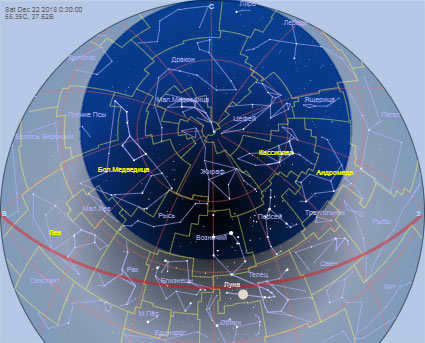
Virtual planetarium
Figure 2: Interactive map showcasing the celestial landscape above Moscow – to zoom in, simply click on the “Expand” icon located in the top right corner. Additionally, you have the ability to adjust the time and geographic coordinates of the region by accessing the options in the top left corner of the map.
Constellations that do not appear in the middle and subtropical latitudes are grouped together in a small, compact cluster, so there is no need to specify their order.
However, in larger groups with numerous constellations, it is more practical for observers to list the constellations individually in the order that they appear along the plane of the celestial equator counterclockwise. In this scenario, the most convenient reference line is not the zero meridian, but the line that runs through Polaris, Dubhe, and Merak of the Big Dipper (Fig. 3). If these stars are difficult to distinguish due to poor atmospheric transparency, then not much can be seen in such a sky.
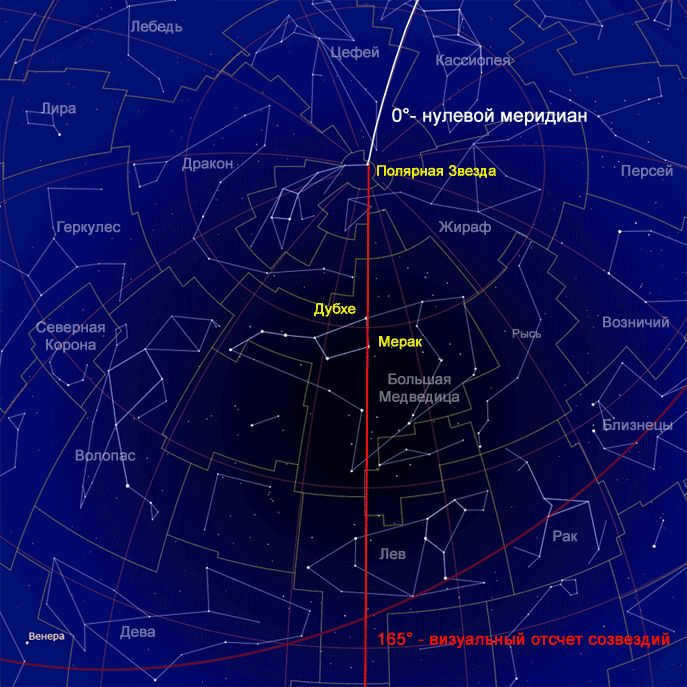
Fig.3. The night sky is filled with stars and constellations. One important line to note is the prime meridian (white), which marks the beginning of visual counting of constellations (red). This line is particularly helpful in locating Polaris, also known as the North Star, and the Little Dipper.
To the south of the constellations that never set, there are partially setting constellations. These constellations have at least one star that falls within the polar circle of the non-setting stars. In the Moscow sky, there are 15 partially setting constellations, listed clockwise:
- The Big Dipper
- Hound Dogs
- Volopassus
- Northern Crown
- Hercules
- Lyre
- Swan
- Pegasus
- Andromeda
- Triangle
- Perseus
- Ascendant
- Gemini
- Lynx
- Little Leo
Further to the south, you can observe the constellations that lie within the boundaries established by the International Astronomical Union. Moving from north to south, the following constellations can be seen above Moscow:
- Leo
- Sextant
- Cup
- Veronica’s hair
- The maiden
- Raven
- Snake
- Libra
- Serpentine
- Shield
- Vixen
- Arrow
- Dolphin
- Eagle
- Capricorn
- Small Horse
- Aquarius
- Pisces
- Whale
- Aries
- Taurus
- Orion
- Hare
- Little Dog
- Unicorn
- Big Dog
- Cancer
And on the horizon in the south, you can see some constellations, where occasionally a star peeks out from behind the horizon.
In the starry sky of Moscow, at different times of the year, you can spot 15 partially visible constellations:
1. Hydra;
2. Centaurus;
3. Wolf;
4. Scorpion;
5. Sagittarius;
6. Microscope;
7. Southern. Fish;
8. Sculptor;
9. Furnace;
10. Eridanus;
11. Chisel;
12. Dove;
13. Feed;
14. Compass;
15. Pump.
So, there are stars from a total of 63 constellations that can be seen in the Moscow sky!
It is most convenient to check for the presence or absence of constellations in an alphabetically ordered list, so here is an alphabetical list of constellations that are visible in the sky of Sochi:
Andromeda, Gemini, Big Dipper, Big Dog, Libra, Aquarius, Aquarius, Ascendant, Wolf, Volopassus, Veronica’s Hair, Raven, Hercules, Hydra, Dove, Hound Dogs, Virgo, Virgo, Dolphin, Dragon, Unicorn, Giraffe, Hare, Serpent, Snake, Cassiopeia, Whale, Capricorn, Compass, Corma, Swan, Lion, Lyra, Fox, M. Horse, M. Dog, Little Lion, Little Bear, Microscope, Pump, Aries, Eagle, Orion, Pegasus, Perseus, Furnace, Cancer, Incisor, Pisces, Lynx, N. Crown, Sextant, Scorpio, Sculptor, Sagittarius, Sagittarius, Taurus, Triangle, Centaurus, Cepheus, Cup, Shield, Eridanus, South Fish, Lizard.
Another unique feature of the Moscow night sky is the selection of constellations that have the privilege of passing directly overhead at midnight, providing optimal conditions for stargazing:
From January 30 to April 29, the Big Dipper is visible in the Moscow sky.
From April 30 to July 14, the Dragon takes its place.
Then, from July 15 to August 1, the Swan gracefully appears.
During August 2 to August 28, the constellation Cepheus can be seen.
From August 29 to September 5, the Lizard makes its appearance.
Following that, from September 6 to October 19, Cassiopeia takes its turn.
From October 20 to November 14, the Perseus constellation can be observed.
Then, from November 15 to December 9, the Giraffe graces the Moscow sky.
From December 10 to December 26, the Chariot constellation shines bright.
And finally, from December 27 to January 29, the Lynx takes its place in the Moscow zenith.
In total, there are 10 constellations that pass through the zenith in Moscow.
Discover the Night Sky in Moscow
Explore the Online Mini Planetarium
Interactive Star Map with Constellation Borders and Names Visible from the Latitude of Moscow
Convenient Hotkeys to Navigate the Online Star Map:
(Use the Cursor and Latin Keyboard Layout)
- a → Toggle Haze (Atmospheric Simulation)
- g → Adjust Horizon
- h → Select Map View
- i → Invert Colors
- , → Show Ecliptic
- ; → Draw Meridian Line
- e → Show Equatorial Grid
- z → Show Azimuthal Grid
- m → Show Galactic Grid
- M → Show Milky Way Boundaries
- q → Hide World Sides
- s → Hide Stars
- S → Hide Star Names
- u → conceal the names of celestial bodies
- p → conceal celestial bodies and the Sun
- o → reveal the paths of celestial bodies
- c → reveal diagrams of constellations
- v → conceal the names of constellations
- b → conceal the boundaries of constellations
- R → reveal the radiants of meteor showers
- 8 → set the current time
- j → slow down time
- k → pause time
- l → speed up the countdown
- – → go back one day
- = → go forward one day
- [ → go back one week
- ] → go forward one week
- % → rotate counterclockwise
- ‘ → rotate clockwise
- & → reveal dim stars
- ( → conceal dim stars
1 or ? → display this list on the celestial chart
Sergey Ov (Seosnews9)
25.05. 2018 – Work on this page will continue:
Abstracts:
– Constellations crossing the zenith ✔
– Constellations, asterisms, and the seasons
– Panoramic map of the entire section of the night sky visible from Moscow.
* The starry sky looks similar at similar latitudes. Usually, there is a visual similarity even if the latitude deviates by 1-2 degrees. For example, the sky in Moscow will look similar to the sky in cities such as Vladimir, Cheboksary, Kazan, Naberezhnye Chelny, Chelyabinsk, Kurgan, Omsk, Novosibirsk, Kemerovo, Krasnoyarsk, Severobaikalsk, Glasgow, Edinburgh, Copenhagen, Klaipeda, and Vitebsk. To achieve an exact match between the star map and the sky, you just need to enter the time correction or the coordinates of the corresponding city in the upper left corner of the star map.
Regional star maps are specifically created for large cities and resort areas.
Moscow: Online Mini Planetarium – Map of the Starry Sky above Moscow
St. Petersburg: Web Planetarium – Map of the Starry Sky above St. Petersburg
Nizhny Novgorod: Online Planetarium – Starry Sky Map of Nizhny Novgorod
Novosibirsk: Web Planetarium – Map of the Starry Sky above Novosibirsk
Yekaterinburg: Web Planetarium – Map of the Starry Sky above Yekaterinburg
Kazan: Planetarium with Online Settings – Map of the Starry Sky above Kazan
Krasnodar: JavaScript Planetarium – Starry Sky Map over Krasnodar
Samara: Online Planetarium – Starry Sky Map over Samara
Krasnoyarsk: JavaScript Planetarium – Map of the Starry Sky above Krasnoyarsk
Chelyabinsk: JS Planetarium – Map of the Starry Sky above Chelyabinsk
Omsk: Online Calculation of Constellation Pattern – Map of the Starry Sky above Omsk
Perm: Online Constellation Chart Calculation – Map of the Starry Sky above Perm
Voronezh: Online Constellation Mapping – Map of the Starry Sky over Voronezh
Murmansk: Explore the starry sky over Murmansk with our virtual planetarium
Vladivostok: Discover the starry sky over Vladivostok with our Java Script Planetarium
Petropavlovsk-Kamchatsky: Experience the starry sky over Petropavlovsk-Kamchatsky with our online planetarium
Sochi: Dive into the starry sky over Sochi with our online planetarium software
Crimea: Immerse yourself in the starry sky over Crimea with our online planetarium.
Our upcoming cities include Chelyabinsk, Omsk, Rostov-on-Don, Ufa, Perm, Voronezh, Volgograd, Saratov, Kaliningrad, Sevastopol, Tyumen.
We have already created pages for “Starry sky” in Chelyabinsk, Omsk, Perm, and Voronezh.
Explore an interactive map of the starry sky in any area at any time:
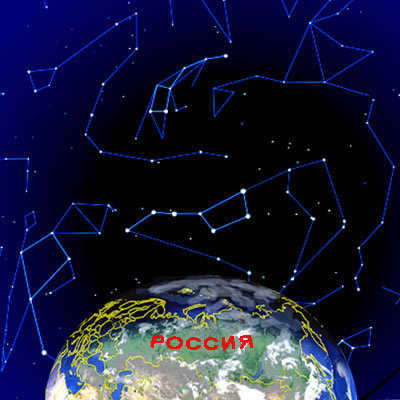
Russia stands out as the sole nation where its people can experience both the sunrise and sunset simultaneously. However, this unique phenomenon depends on the location of its inhabitants. Those living on the eastern borders of the country have the privilege of witnessing the dawn, while those residing in the west can bid farewell to the sunset, or vice versa (Fig.1).
The map displayed on this page enables you to generate the depiction of the celestial sky corresponding to the specified time and location, with the option to make adjustments in interactive mode for both the date and geographical coordinates.
It is important to note that when utilizing the map, the actual local time may vary from both Moscow time and the local time zone. It is therefore advisable to mention that the calculations for constructing the celestial sky image are based on the time settings on your device:
Interactive Planetarium Online
Input the name of the city or town on the map in the “Find” menu
Sunrise: 4:20
Sunset: 19:44
Solar Noon: 12:02:20 MSK
( Wed, 01 May 2019 09:02:20 GMT )
Sun elevation angle: 48.611°
Starry Sky , Nizhny Novgorod
⟳ – Return to the initial parameters and set the current time
Save location *:
http://www.abc2home.ru/znaki_zodiaka/sozvezdiya/stellar_sky_russia.html
* Attention! In some browsers even after
refreshing the page, you need to manually add its address to bookmarks.
Fig.2. Starry Sky Map
– To expand the map, click on the “Expand” icon located in the top right corner. You also have the option to adjust the time and geographic coordinates of the area by using the controls in the top left corner of the map.
– In order to activate real time mode, click on the sky image to enable the cross-shaped cursor. Then, switch your keyboard to the Latin font and press the “8” button to set the current time. Finally, press the “l” button (lowercase L) to activate real time mode. Please note that enabling real time mode on your mobile device may drain its battery quickly due to the high power consumption.
The constellations in the starry sky of a particular area can be categorized into four distinct groups:
– constellations that never set;
– constellations that partially set;
– constellations that fully set and remain visible;
– constellations that partially appear and disappear.
From the perspective of an observer, it is recommended to list constellations in groups with a large number of them, based on their proximity, in a counterclockwise order along the plane of the celestial equator. In this scenario, the most convenient reference line is not the zero meridian, but the line that passes through Polaris, Dubhe, and Merak of the Big Dipper (Fig. 3). If these stars are hardly distinguishable due to poor atmospheric transparency, then in such a sky, the only celestial object that can be seen is the Moon.

Figure 3: The night sky with the celestial line used for visual counting of constellations (marked in red). This line serves as a reliable guide for locating Polaris and the Little Bear.
Our constellations that do not set are clustered around the celestial north pole, and the area of stars that do not set forms a circle with a center that is almost the same as Polaris. The further north the observer is, the more constellations that do not set they will see. Therefore, the group of constellations that do not set is a characteristic of the latitude of the area.
If you observe at the Earth’s pole, the list of constellations that do not set will include all constellations whose boundaries do not cross the celestial equator. And for people living in equatorial countries, all constellations will at least partially set.
Murmansk is the northernmost major city in Russia (the largest city in the world above the Arctic Circle), and Makhachkala and Vladivostok are the southernmost major cities. To give a comparison, here are images of the area of constellations that do not set in the sky of the northernmost and southeasternmost cities of Russia – Murmansk and Vladivostok.
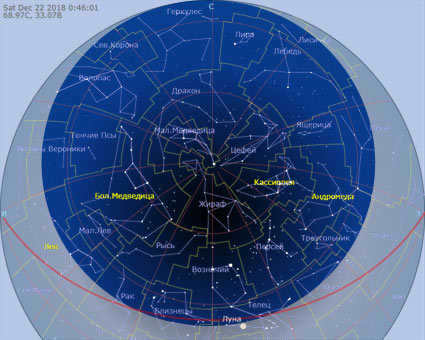
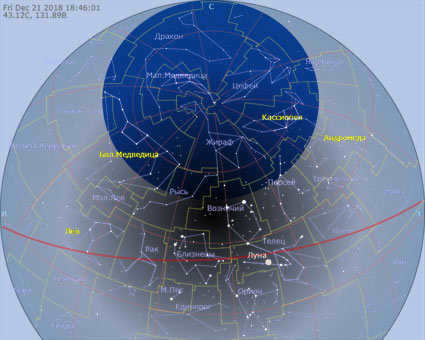
Figure 3 and Figure 4. The regions of stars that do not set in the sky above Murmansk (left) and Vladivostok (right) – as you move further south, the area of stars that do not set becomes smaller.
Our country is so vast that people in the eastern and western parts of the country observe the night sky in completely different ways simultaneously!
Address to educators
Regrettably, due to the page’s format and the specific nature of the information, it is not feasible to provide a list of constellations categorized by groups or other characteristics of the night sky for a particular region. As a result, separate pages have been created for the largest cities in Russia.
Dear educators! If you require information about the night sky over your city or town in the form of a separate page for conducting a lesson, you can request it on our forum. To place an order, simply register on the forum and submit a screenshot of the map on this page indicating the coordinates of the area for which you need materials. Currently, we are able to fulfill your order within three business days. (Orders for educators are free of charge.)
Nizhny Novgorod Starry Sky – Explore the Mini Planetarium Online
Discover the Map of the Starry Sky with Constellation Borders and Names
Use Hot Keys to Control the Online Starry Sky Map: (Navigate with Cursor and Latin Keyboard Layout)
- a → Toggle Haze (Atmospheric Simulation)
- g → Adjust Horizon
- h → Select Map View
- i → Invert Colors
- , → Show Ecliptic
- ; → Draw Meridian Line
- e → Show Equatorial Grid
- z → Show Azimuthal Grid
- m → Show Galactic Grid
- M → Show Milky Way Boundaries
- q → Hide the Sides of the World
- s → Hide Stars
- S → Hide Star Names
- u → Hide Planet Names
- p → hide the Sun and planets
- o → display the orbits of the planets
- c → show diagrams of constellations
- v → hide the names of constellations
- b → hide the boundaries of constellations
- R → display the radiants of meteor showers
- 8 → set the current time
- j → slow down time
- k → pause time
- l → speed up the countdown
- – → go back one day
- = → go forward one day
- [ → go back one week
- ] → go forward one week
- % → rotate counterclockwise
- ‘ → rotate clockwise
- & → show dim stars
- ( → hide dim stars
1 or ? → show this list on the star map
Sergey Ov ( Seosnews9 )
* The starry sky looks similar at similar latitudes. Generally, the visual similarity is maintained with a deviation of 1-2 degrees in latitude. This means that the sky in Nizhny Novgorod will look roughly the same as in other cities such as Cheboksary, Yoshkar-Ola, Izhevsk, Yekaterinburg, Bratsk, Riga, Tver, Ivanovo. To ensure an exact match between the virtual map and the real sky, you just need to enter the time correction or coordinates of the corresponding city in the upper left corner of the star map.
Regional star maps are specifically designed for large cities and resort areas.

